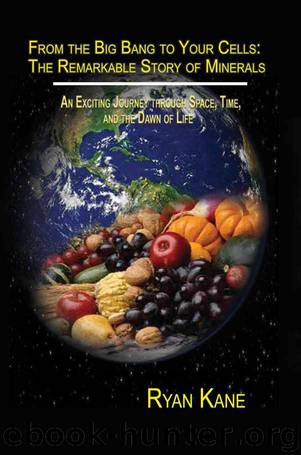From the Big Bang to Your Cells: The Remarkable Story of Minerals by Ryan Kane

Author:Ryan Kane [Kane, Ryan]
Language: eng
Format: epub
Publisher: Fathom Publishing
Published: 2015-10-05T04:00:00+00:00
Chapter 10
The Macrominerals in People (continued)
Phosphorus
Phosphorus comes from the Greek word phosphoros, which means “light bearer” and was the ancient name for the planet Venus. In 1669, the German physician Hennig Brand first isolated phosphorus by boiling and then filtering 60 buckets of urine. This process produced a white material that glowed in the dark and burned brilliantly. Since that time, phosphorescence has been used to describe substances that glow in the dark without burning. Fortunately, today phosphorus is obtained from phosphate rocks. Some phosphorus compounds are used to as a cleaning agent, water softener, and to make china and baking powder. Phosphoric acid is a phosphorus compound that is found in carbonated soft drinks and is used to create fertilizers.
According to Dr. Matthew A. Pasek at the University of Arizona’s Lunar and Planetary Laboratory, phosphorus is an important element for all living organisms, and ranks fifth in importance right after carbon, hydrogen, oxygen, and nitrogen. In fact, Dr. Pasek has stated, “there’s approximately one phosphorus atom for every 2.8 million hydrogen atoms in the cosmos, every 49 million hydrogen atoms in the oceans, and every 203 hydrogen atoms in bacteria. Similarly, there’s a single phosphorus atom for every 1,400 oxygen atoms in the cosmos, every 25 million oxygen atoms in the oceans, and 72 oxygen atoms in bacteria. The numbers for carbon atoms and nitrogen atoms, respectively, per single phosphorus atom are 680 and 230 in the cosmos, 974 and 633 in the oceans, and 116 and 15 in bacteria.” These comparisons make phosphorus sound extremely rare when compared to these other important elements. However, the question remains about how phosphorus became so abundant on planet Earth in the first place.
When Earth was first forming, and long before life began, researchers at the University of Arizona theorize that phosphorus was delivered by violent impacts with meteorites that were rich in iron-nickel metals that often contained phosphorus. Dr. Pasek explains that meteorites tend to have various compound minerals that contain phosphorus, with the most important compound being schreibersite, which is extremely rare on Earth.
When this mineral comes into contact with water, various forms of phosphorus compounds will develop, including a form of phosphate that is two phosphorus atoms bound to seven oxygen atoms. This compound is used in photosynthesis and closely resembles ATP, the cellular energy that provides growth and movement. Since phosphorus is required to provide structure to DNA and RNA, it is thought that these iron meteorites that also contained phosphorus landed near fresh water, which eventually formed various phosphate bonds with carbon-containing compounds, and went on to participate in many other types of biological processes.
Meteorites such as these are the building blocks of planets. Ones that contain heavy amounts of iron help to form the metallic core of a planet, while other meteorites that contain silicates deliver elements that form the mantle. According to Dante Lauretta, a University of Arizona professor of planetary sciences, life can originate in solar systems only if there is an asteroid belt that contains these types of meteorites.
Download
This site does not store any files on its server. We only index and link to content provided by other sites. Please contact the content providers to delete copyright contents if any and email us, we'll remove relevant links or contents immediately.
Nutrition for Sport, Exercise, and Health by Spano Marie & Kruskall Laura & Thomas D. Travis(3562)
Nutrition for Sport, Exercise, and Health by Marie Spano & Laura Kruskall & D. Travis Thomas(3554)
The Sprouting Book by Ann Wigmore(3420)
Flavor Flours by Alice Medrich(2651)
Memory Rescue by Daniel G. Amen(2268)
Superfood Smoothie Bowls: Delicious, Satisfying, Protein-Packed Blends that Boost Energy and Burn Fat by Chace Daniella(2240)
Dirty Genes by Ben Lynch(2165)
The Bad Food Bible by Aaron Carroll(2126)
The Poisoner's Handbook by Deborah Blum(1986)
Genius Foods by Max Lugavere(1978)
Good Calories, Bad Calories by Gary Taubes(1957)
The Main Street Vegan Academy Cookbook by Victoria Moran(1943)
The I Quit Sugar Cookbook by Sarah Wilson(1881)
Core Performance Essentials by Mark Verstegen(1865)
Memory Rescue: Supercharge Your Brain, Reverse Memory Loss, and Remember What Matters Most by Amen Dr. Daniel G(1855)
Big Girls Do It Stronger by Jasinda Wilder(1810)
Android App Development by Franceschi Hervé J.;(1737)
Sugar Crush by Dr. Richard Jacoby(1690)
Dr. Colbert's Keto Zone Diet by Don Colbert(1551)
